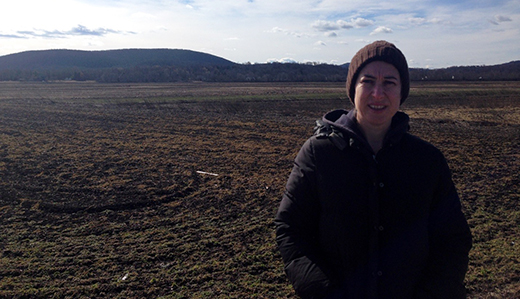Shayna said, “What I love most is this is the first time I’ve been in charge and worked for myself. I get to make decisions and see what happens. It makes you better and makes you try harder.” It’s going well, she said. “Last year, our first here, we had a bumper crop.”
On a cold March day, the high tunnel at Dirty Boots Farm had plenty of crops growing. Their seasonal vegetables include spinach, peas, salad mix, squash, cucumbers, carrots, okra, tomatillos, potatoes, broccoli, cabbage, cauliflower, melons, radicchio, beets, rutabaga, and even some rare things like husk cherries.
 Though the high tunnel brought them into the NRCS field office for the first time, Shayna and Matt’s assistance from NRCS has gone beyond that into many other conservation practices. Their NRCS conservation plan will help them with their certification application package; they expect to receive organic certification by 2017, after the required three-year waiting period.
Though the high tunnel brought them into the NRCS field office for the first time, Shayna and Matt’s assistance from NRCS has gone beyond that into many other conservation practices. Their NRCS conservation plan will help them with their certification application package; they expect to receive organic certification by 2017, after the required three-year waiting period.
Shayna has always farmed organically, saying, “Just organic is not enough. We want to really focus on building soil fertility.” Wind is an additional challenge in the valley, so planting a variety of cover crops to prevent erosion is extremely important. Shayna said, “I’ve learned a lot about topsoil loss in this country, so stopping soil erosion is a big priority of mine. Next year, I hope to expand with perennial green mulch.”
Helping others through farming is a passion of Shayna’s. She got the farming bug after college where she became interested in other cultures’ food and land issues. She farmed for urban agriculture non-profits in Brooklyn, New York, including “Added Value” at the 2.5 acre Red Hook Community Farm, and “Project Eats” on farms that work with homeless shelters and high school kids.
Right now, she and Matt do all of the farming on their own, but in the future she wants to grow an internship program and maybe offer some Brooklyn high school students the opportunity to live in the country for the summer and earn a good wage on the farm.
Beyond helping other people, Dirty Boots Farm sees the evidence of their farm’s harmony with nature. The wildlife in the area is abundant. “There are lots of critters in the canals–fish, herons, and pollinators,” said Shayna. “The other day I saw a beautiful blue heron fishing in the ditches, and a huge snapping turtle,” she said.
She sees the relationship with NRCS as continuing, pursuing her current conservation practices through the Environmental Quality Incentives Program Organic Initiative (EQIP-OI) and eventually applying for other programs to pursue additional conservation actions. Much like getting organic certification, “With NRCS there is a lot of paperwork, but it’s also good for us to keep the records,” she said.
Click on these links to learn more about NRCS assistance for high tunnels and for organic producers.